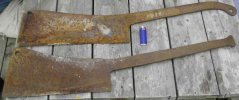- Joined
- Nov 7, 2016
- Messages
- 796
Check my wording, I said I partially agree. And I used the words more in common.I'm confused,Woodcraft I cannot for the life of me see how a flat axe is more similar to a billhook. It's shaped like an axe, often times with a nearly identical profile. A full tang chisel is still obviously a chisel, a full tang knife or sword is still a knife or sword, etc. A bill hook is a brush clearing knife, and has a brush clearing hooked blade. An axe is for chopping, and has a small but at the end of a longer handle.
But to respond......
An ax is for whatever task it was designed for but..... Generally speaking an ax is most commonly used for chopping and splitting. I would bet dollars to doughnuts that if you grabbed the modern flat stock Buck ax, a woodsman's pal and a decent scout hatchet you would after a day of use come to the conclusion that the buck ax is closer in relationship in both construction and effective use to the woodsman's pal than it is to an old plumb scout hatchet.
There is a reason for quite some time flat stock axes have been referred to as ax shaped knives........
I look forward to someone finding the sweet spot in the middle.
Profile is only a small part of what makes an ax....


